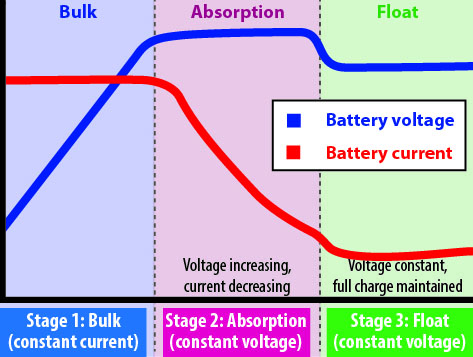Pb charging: absorption finishing amps and state of health
tracking endAmps
The Absorption stage of lead-chemistry battery charging is characterized by constant voltage (Vabs) and decreasing current. The battery takes less and less current as it approaches full charge, and finally plateaus at a low rate. Current is the red line in this graphic:
[caption id=”” align=”aligncenter” width=”257”] https://chargetek.com/chargingbasics.html[/caption]
https://chargetek.com/chargingbasics.html[/caption]
That leveled off terminal rate in the right third is called endAmps, finishing amps, tail current, etc. It is typically C/200 to C/100, or 0.5 to 1A per 100Ah of battery capacity. Fresh batteries tend to have lower endAmps reached more quickly, and tired / old / abused batteries tend to have higher endAmps reached more slowly (longer Absorption phase required).
> I have repeated this test with AGM batteries [in] worse shape that exceeded 7 hours to attain 100% SOC, likely due to sulfation.
If that is so, one might be able to record endAmps monthly as a metric for battery state of health. It might not tell you when a particular battery is toast, but increasing endAmps would be an indication of design, all other things being equal.
MainSail suggests endAmps greater than the 0.75%C (C/133) indicates the battery is no longer running at full capacity:
Over many years of capacity testing hundreds and hundreds of batteries, flooded, GEL and AGM I have yet to see a lead acid battery that could [deliver] its full storage potential at anything less than 0.75% in tail current at absorption voltage.
The wording is a bit odd there, and IMO means “worse (higher) tail current than 0.75% rather than “ < 0.75%”.
increasing Vabs when Absorption duration is limited
Charge controllers have different strategies for knowing when to end Absorption
-
high end controllers may hold Absorption until the specificed endAmps is achieved as long as it takes (or as long as sunlight is available).
-
mid-range controllers may hold Absorption for a duration specified by the user
-
low-end controllers usually hold Absorption for a set duration like 2 hours.
In each of these cases, batteries in poor health may require longer than the available time to drop to endAmps. One workaround for maxxed Absorption duration is to increase Vabs. I propose increasing Vabs in 0.1v - 0.2v steps until endAmps can be achieved within the available duration.
Caution: as Vabs creeps up you will either hit the maximum allowable setpoint (AGM, Gel) or need to water more often (flooded).
longshot: decreasing charge rate when Absorption duration is limited
Charge time remains relatively constant whether charging at max or min rates for the battery. Again quoting Mainsail:
charging AGM at C/2.5 (max rate) resulted in the battery being 63.3% “full”[3)](http://rvwiki.mousetrap.net/doku.php?id=opinion:frater_secessus:charging_faster#fn__3) at Vabs and being fully charged in **5hrs, 30 minutes** (20min Bulk, 5hr 10mins Absorption) charging AGM at C/5 (min rate) resulted in the battery being 77.4% “full” at Vabs and being fully charged in **5hrs, 42 minutes** (76min Bulk, 4hr 26mins Absorption)
It is conceivable that charging at a minimum rate (particularly for flooded that can be successfully charged as low as C/10) could also help absorption finish faster. Overall time would be about the same but the charging process would spend more time in Bulk which by definition is not time-limited.
anecdote
My own set of flooded golf cart batts (2x 6v in series) is Absorped at 14.6v @ 70F and finishes at 1.79A, or 0.81% (C/123) in about 2.5 hours. This suggests I have lost some capacity in 589 cycles at 50% DoD (installed 9/24/2018). I wasn’t measuring it before so I can’t compare to new, and the loss of capacity is not noticeable in practical experience.
When my bank can no longer reach endAmps within the three hour max the controller allows I will try increasing Vabs.